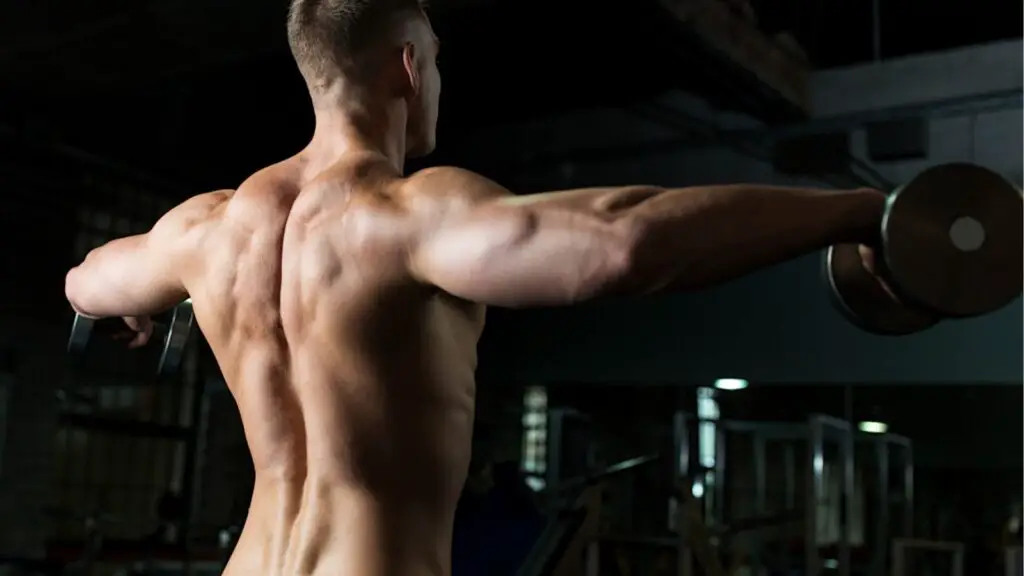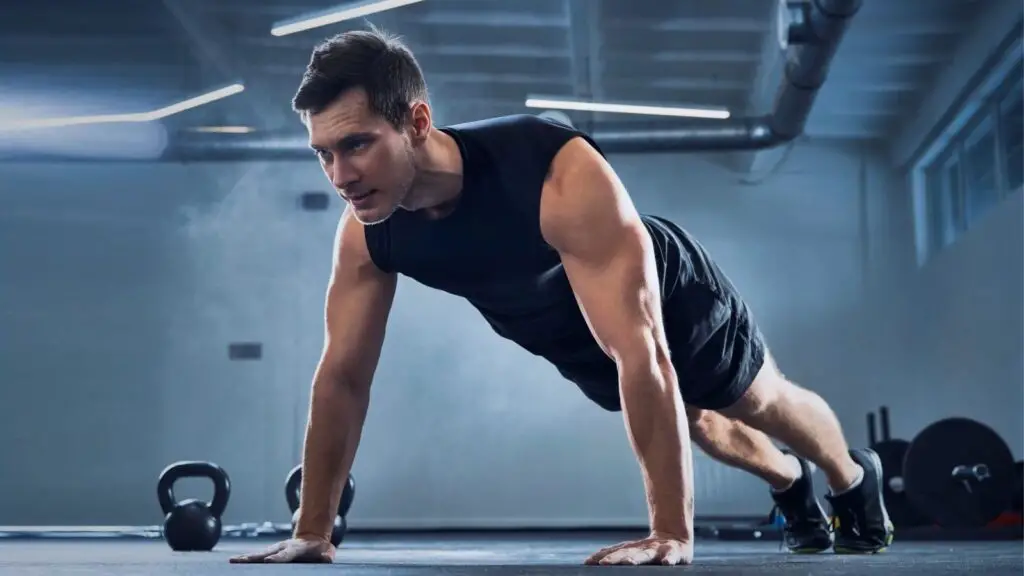Squats and Lunges are two leg exercises, usually part of everybody’s leg routine.
Is it actually worth doing both exercises together or is it better to include just one?
In this article we look at Squats vs Lunges, breaking down each exercise and seeing the value they bring to your workout.
What are the similarities?
Squats and lunges are both compound lower body exercises that work multiple muscle groups and provide a variety of benefits.
Here are some of the key similarities between squats and lunges:
- Lower Body Engagement: Both squats and lunges engage the muscles of the lower body, including the quadriceps, hamstrings, glutes, and calves. They are effective exercises for building strength and muscle in these muscle groups.
- Functional Movement: Both exercises mimic movements that are part of our daily activities. Squats simulate the motion of sitting down and standing up, while lunges resemble stepping forward or backward.
- Core Activation: Squats and lunges require core stability to maintain balance and proper form during the movements. This helps strengthen the core muscles.
- Balance and Coordination: Both exercises improve balance and coordination, as they involve maintaining stability while moving through various planes of motion.
- Joint Flexibility: Squats and lunges require joint mobility in the hips, knees, and ankles, which can enhance overall joint health and flexibility.
- Muscle Stabilization: These exercises engage stabilizer muscles in the hips and pelvis, which can improve joint stability and reduce the risk of injury.
- Progression: Both squats and lunges can be modified to increase or decrease the level of difficulty, making them suitable for individuals of various fitness levels.
- Versatility: Squats and lunges can be performed with different variations, such as bodyweight squats, goblet squats, Bulgarian split squats, walking lunges, and more, allowing for variety in your workout routine.
- Compound Movements: Both squats and lunges are compound exercises, meaning they work multiple muscle groups simultaneously. This can lead to efficient calorie burning and muscle development.
- No Equipment Required: Squats and lunges can be performed with or without additional weights or equipment. This makes them accessible and suitable for home workouts or when you have limited equipment available.
- Leg Strength: Both exercises contribute to improved leg strength, which can enhance athletic performance, support daily activities, and reduce the risk of lower body injuries.
- Variety of Fitness Goals: Squats and lunges can be incorporated into various fitness routines, including strength training, muscle-building, endurance training, and functional fitness programs.
Depending on your fitness goals and preferences, you can choose to incorporate both exercises into your workout routine to achieve a balanced lower body workout.
For some people it might be a better idea to emphasize one over the other to target specific muscle groups.
What are the differences?
Squats and lunges are both lower body exercises that engage multiple muscle groups, but they have distinct differences in terms of movement, muscle activation, and execution.
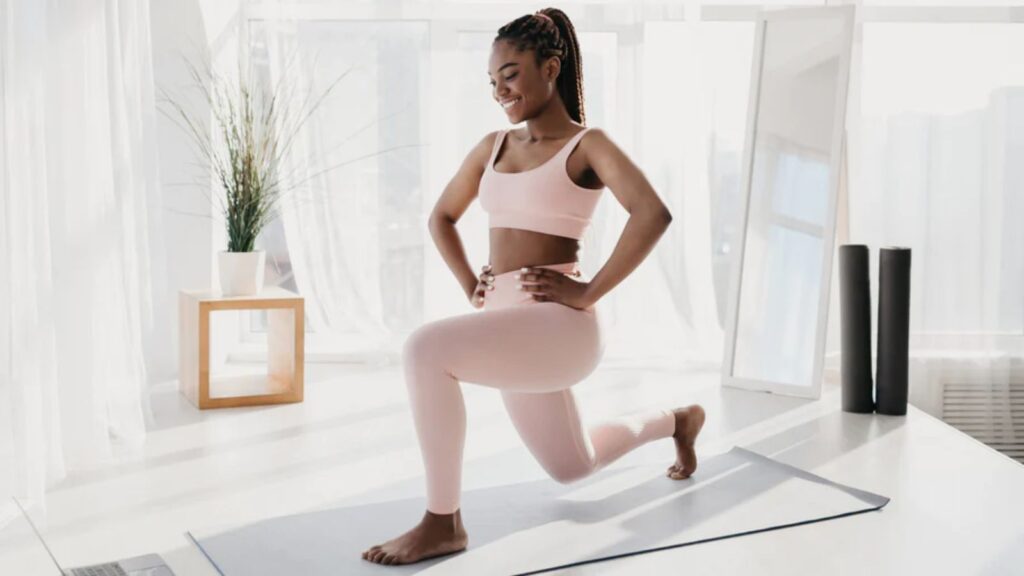
Here are the primary differences between squats and lunges:
Squats
- Movement Pattern: Squats involve a vertical up-and-down movement. You start by lowering your body straight down, as if sitting back into an imaginary chair, and then push back up to the standing position.
- Both Legs Simultaneously: In squats, both legs work together to support your body weight. They share the load evenly as you descend and ascend.
- Muscle Emphasis: Squats primarily target the quadriceps (front thigh muscles), glutes (buttocks), hamstrings (back thigh muscles), and lower back muscles. They are often considered one of the best exercises for overall lower body development.
- Balance and Stability: Squats require balance and stability, especially when using heavy weights. They help develop core strength and improve posture.
- Variations: There are numerous squat variations, including bodyweight squats, barbell squats, front squats, and goblet squats. These variations can target specific muscle groups and provide variety in your workout routine.
Lunges
- Movement Pattern: Lunges involve a step-forward or step-backward movement. In a basic lunge, you step one foot forward or backward, bend both knees, and then return to the starting position.
- Single-Leg Focus: Lunges are typically performed one leg at a time, which means that each leg works independently. They are unilateral exercises, unlike squats, which are bilateral.
- Muscle Emphasis: Lunges primarily target the quadriceps, hamstrings, glutes, and calf muscles. They also engage the stabilizing muscles in the hips and thighs. Lunges can emphasize one leg more than the other, which can help address muscle imbalances.
- Variations: Lunges come in various forms, including forward lunges, reverse lunges, walking lunges, and lateral lunges. These variations allow you to target different muscle groups and add variety to your workout.
- Balance and Coordination: Lunges require good balance and coordination, as you need to stabilize your body on one leg while moving the other.
- Functional Movement: Lunges mimic stepping motions, which are functional movements used in everyday activities, such as walking, climbing stairs, and getting up from a seated position.
While squats and lunges have different execution and muscle emphasis, they both offer valuable lower body training.
Adding both exercises into your workout routine can provide a balanced and comprehensive approach to lower body strength and muscle development.
Target muscle
While squats and lunges share some common target muscles, they emphasize different muscles to varying degrees.
Here are the primary target muscles for squats and lunges:
Squats
- Quadriceps (Front Thigh Muscles): Squats heavily engage the quadriceps, making them a primary target. The quadriceps work to extend the knee joint during the upward phase of the squat.
- Glutes (Buttocks): Squats also place significant emphasis on the gluteal muscles, specifically the gluteus maximus. The glutes play a crucial role in hip extension during the squat.
- Hamstrings (Back Thigh Muscles): While not the primary target, the hamstrings work to stabilize the knee joint during squats, especially in the eccentric (lowering) phase.
- Calves: The calf muscles, particularly the gastrocnemius and soleus, are engaged to stabilize the ankle joint.
- Lower Back: The erector spinae muscles of the lower back are activated to provide stability to the spine during squats.
Lunges
- Quadriceps (Front Thigh Muscles): Lunges primarily target the quadriceps, similar to squats. Each leg works independently in lunges, making them a unilateral exercise that focuses on the quadriceps.
- Glutes (Buttocks): Lunges also engage the gluteal muscles, particularly the gluteus maximus, to stabilize the hip and extend the leg.
- Hamstrings (Back Thigh Muscles): The hamstrings play a role in lunges, working to stabilize the knee joint and providing support during the movement.
- Calves: Like in squats, the calf muscles are involved in lunges to stabilize the ankle joint.
- Hip Adductors and Abductors: Lunges require engagement of the inner and outer thigh muscles (adductors and abductors) to provide balance and stability during the lunge.
- Hip Flexors: The hip flexor muscles, including the iliopsoas, are engaged as you step forward or backward in lunges.
- Stabilizing Muscles: Lunges engage a wide range of stabilizing muscles in the hips and thighs due to the unilateral nature of the exercise.
Both squats and lunges are excellent lower body exercises that target various muscles.
However, lunges are different compared to squats in that they are unilateral exercises, working one leg at a time, which can help address muscle imbalances and provide additional emphasis on stability and coordination.
How to do Squats?
Squats are a fundamental lower body exercise that can help you build strength and muscle in your quadriceps, glutes and hamstrings.
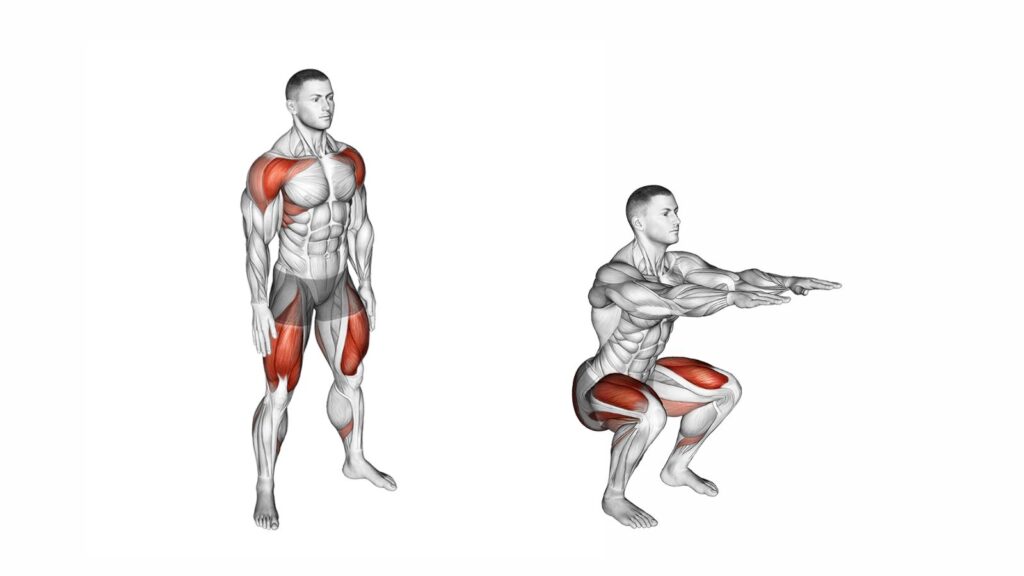
Here’s how to perform a basic bodyweight squat with proper form:
1. Starting Position
- Stand with your feet shoulder-width apart, toes pointing slightly outward.
- Keep your head in a neutral position, looking straight ahead, and maintain a straight back with your shoulders relaxed.
2. Execution
- Inhale and initiate the squat by bending your hips and knees simultaneously. Imagine sitting back into an imaginary chair.
- Lower your body down by pushing your hips back and bending your knees, keeping your chest up and your back straight.
- Continue to lower yourself until your thighs are parallel to the ground or as far as your mobility allows. Your knees should be aligned with your toes.
3. Depth and Range of Motion
- Squat to a comfortable depth that is appropriate for your current level of flexibility and strength.
- It’s more important to maintain good form than to go very deep if it compromises your technique.
4. Return to the Starting Position
- Exhale and push through your heels to straighten your hips and knees and return to the standing position. Keep your chest up and your back straight throughout the ascent.
5. Complete the Repetition
- Repeat the squat for the desired number of repetitions.
- Focus on proper form, ensuring your knees do not cave in and that your weight is evenly distributed on your feet.
Tips for Proper Form:
- Keep your chest up and your back straight throughout the entire squat.
- Ensure that your knees track over your toes rather than caving inward.
- Your heels should remain flat on the ground throughout the movement.
- Maintain a neutral spine position by looking straight ahead.
- Engage your core muscles to stabilize your torso.
Variations and Progression:
Once you’ve mastered the basic bodyweight squat, you can progress to more challenging variations, such as goblet squats, front squats, or back squats, which involve using additional weight.
These variations can increase the intensity of the exercise and help you build more strength and muscle in your lower body.
Incorporating squats into your workout routine can be a valuable addition for improving lower body strength, mobility, and overall fitness.
When should you do Squats?
The timing of when to do squats depends on your fitness goals, workout routine, and personal preferences. Squats can be integrated into various parts of your workout program or adapted to suit your specific needs.
Here are some common scenarios for doing squats:
- Leg Day: Many people incorporate squats into their leg day workout. Leg day typically focuses on exercises that target the lower body, including squats, lunges, and leg presses.
- Strength Training: Squats are commonly used in strength training routines. You can perform squats at the beginning of your strength training workout when you have the most energy and strength to lift heavy weights.
- Full-Body Workouts: If your goal is a full-body workout, you can include squats as a compound exercise that engages not only the lower body but also the core and upper body muscles for stability.
- Warm-Up: Squats can be used as part of your warm-up routine to prepare your lower body for more intense exercises. Performing bodyweight squats can increase blood flow to the muscles and improve mobility.
- Functional Training: If your aim is to improve functional fitness, squats can be performed as part of a functional training routine that mimics real-life movements like squatting down and standing up.
- Incorporated with Other Exercises: You can include squats as part of circuit training or supersets to add variety and challenge to your workouts.
- Anytime, Anywhere: Squats are a versatile exercise that can be done at home, in the gym, or even outdoors. This flexibility allows you to incorporate squats into your workout routine whenever it’s most convenient for you.
- Recovery and Mobility: Squats can also be used for recovery and mobility work. Bodyweight squats or assisted squats can be performed as a mobility exercise to improve hip and ankle flexibility.
Ultimately, the timing of squats in your workout routine should align with your fitness goals and the structure of your program.
If you’re unsure about the best timing for squats, consider consulting with a fitness professional who can help you design a customized workout plan based on your individual needs and objectives.
Benefits of Squats
Squats are one of the best exercises for legs, offering numerous benefits for individuals of all fitness levels.
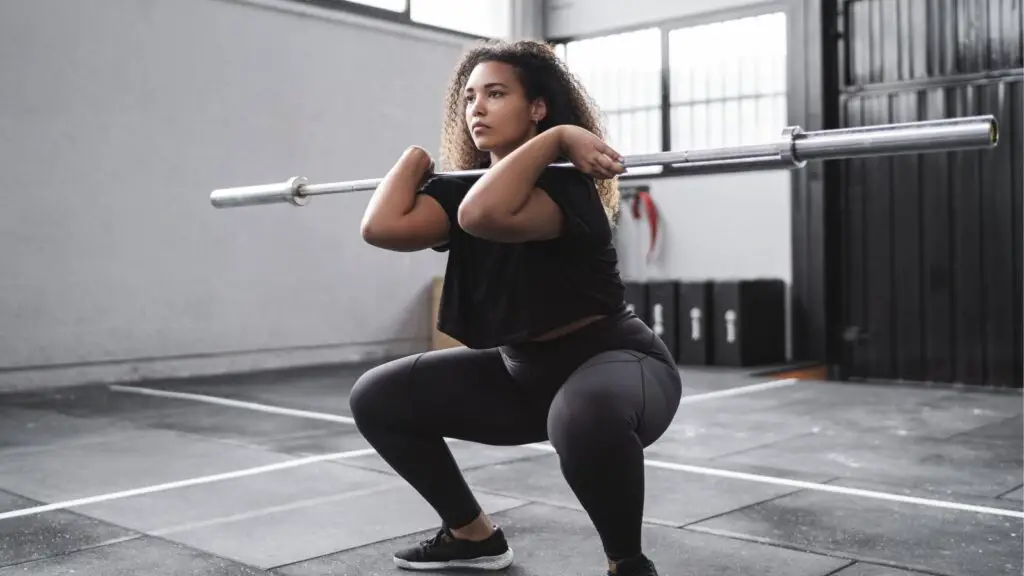
Here are some of the key benefits of doing squats:
- Leg Strength: Squats primarily target the quadriceps, hamstrings, and glutes, making them an excellent exercise for building lower body strength.
- Functional Movement: Squats mimic the natural movement of sitting down and standing up, making them a functional exercise that improves everyday activities and mobility.
- Core Engagement: Squats require core stabilization to maintain balance and proper form, which helps strengthen the abdominal muscles.
- Glute Development: Squats engage the gluteal muscles, contributing to improved tone and strength in the buttocks.
- Improved Posture: Squats can help improve posture by strengthening the muscles responsible for maintaining an upright position.
- Calorie Burn: Squats, especially when performed with added weight, can increase your metabolic rate and contribute to calorie expenditure, which can aid in weight management.
- Joint Health: Squats are a low-impact exercise, making them gentle on the joints while still providing the benefits of resistance training.
- Variety of Squat Types: There are numerous squat variations, including goblet squats, front squats, back squats, and overhead squats, allowing you to target different muscle groups and add variety to your workouts.
- Balance and Coordination: Squats require balance and coordination, especially when you add weight or perform single-leg squats.
- Core to Extremity Movement: Squats are a “core to extremity” movement, meaning they engage the core muscles first and then transmit force to the extremities, making them efficient and effective for full-body workouts.
- Versatility: Squats can be adapted to suit various fitness levels, from bodyweight squats for beginners to heavy barbell squats for advanced lifters.
- No Equipment Required: Bodyweight squats can be performed virtually anywhere without the need for specialized equipment.
Incorporating squats into your workout routine, whether as a standalone exercise or as part of a larger training plan, can be a valuable addition for improving lower body strength, mobility, and overall fitness.
Cons of Squats
While squats are a highly effective and beneficial exercise for many, there are potential drawbacks or cons to consider, particularly if performed with poor form, too much weight, or by individuals with certain health conditions.
Here are some of the cons or potential issues associated with squats:
- Injury Risk: Squats, especially with heavy weights or poor form, can pose a risk of injury, particularly to the lower back, knees, and hips. Common injuries include strains, sprains, and more serious injuries such as anterior cruciate ligament (ACL) tears.
- Knee Stress: Squats can place a significant load on the knee joints, which can be problematic for individuals with pre-existing knee issues or limited knee mobility.
- Back Strain: Squats can put stress on the lower back, and poor form, excessive rounding or arching of the back, and lifting too heavy a weight can contribute to lower back discomfort or injury.
- Overtraining: Squats are a demanding exercise, and excessive squatting without proper recovery can lead to overtraining and fatigue. Balancing your squat routine with sufficient rest and recovery is crucial.
- Muscle Imbalances: Focusing too heavily on squats without incorporating other exercises can lead to muscle imbalances, as they primarily target the front thigh (quadriceps) and buttocks (glutes).
- High Learning Curve: Proper squat form requires a certain level of technique and flexibility. Beginners may need time and guidance to learn how to squat correctly.
- Equipment Access: To perform certain variations of squats, such as barbell squats, you need access to specialized equipment and a safe environment, like a power rack or squat rack.
- Progression Plateaus: Over time, it may become challenging to increase the difficulty of squats without using very heavy weights. This can lead to progress plateaus if you don’t have access to heavier weights.
- Individual Limitations: Some individuals, due to their age, fitness level, or health conditions, may find squats inappropriate or unsafe. Consulting with a healthcare professional or fitness expert is advisable in such cases.
- Performance Fatigue: Squats are a high-intensity exercise that can lead to performance fatigue, which may affect subsequent exercises in your workout routine.
To mitigate the potential drawbacks of squats, it’s crucial to prioritize safety, proper form, and gradual progression.
It’s also important to balance your workout routine with a variety of exercises that target all major muscle groups and incorporate exercises that address the potential imbalances that squats might create.
How to do Lunges?
Lunges are great for building strength and muscle in the quadriceps, hamstrings, and glutes while also improving balance.
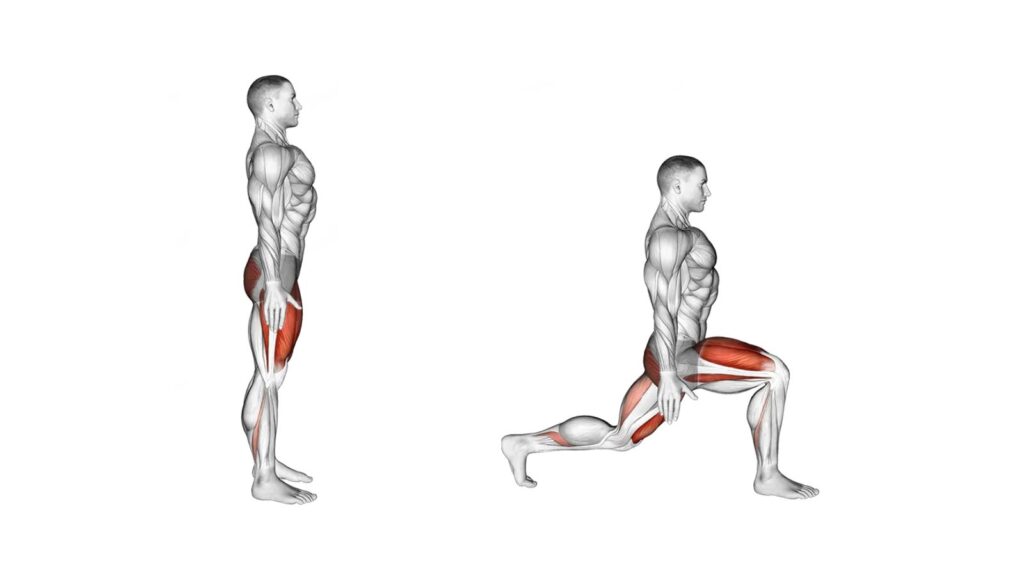
Here’s how to perform a basic lunge without weight:
1. Starting Position
- Stand up straight with your feet hip-width apart, while keeping your core engaged for stability.
2. Take a Step Forward
- Decide which leg you want to start with. In this example, let’s begin with the right leg. Take a step forward with your right leg.
- Your left leg should remain in place and your feet should be about shoulder-width apart.
3. Lunge Down
- Lower your body by bending both knees. As you descend, aim to create two 90-degree angles with your legs.
- Your front knee should be directly above your ankle, and your back knee should hover just above the ground without touching it.
- Keep your torso upright and look forward, avoid leaning forward.
4. Pause and Engage Muscles
- Hold the lunge position for a brief moment to engage the target muscles (quads, hamstrings, and glutes).
5. Push Back Up
- Push off your front foot to return to the starting position.
- Use your front leg to drive the movement, exhaling as you push up.
6. Repeat on the Other Leg
- After completing the desired number of repetitions on one leg, switch to the other leg and perform lunges with the opposite leg forward.
Tips for a Safe and Effective Lunge:
- Keep your movements controlled and avoid rushing through the exercise to maintain proper form.
- Maintain a neutral spine and keep your back straight throughout the movement.
- Ensure that your front knee is aligned with your ankle and does not go past your toes.
- Use your core muscles for balance and stability.
- Keep your chest up and your gaze forward to maintain good posture.
- For added resistance, you can hold dumbbells or a barbell in your hands. Alternatively, you can use a weighted vest.
Lunges can be done in many different ways, including the use of weights for added resistance. This allows you to strengthen your muscles and target them more effectively.
Another way to perform lunges is by doing variations, including reverse lunges (stepping backward), walking lunges (moving forward with each step), and lateral lunges (stepping to the side).
When should you do Lunges?
The timing for when to do lunges can vary based on your overall workout routine and fitness goals.
Here are some common scenarios for incorporating lunges into your training schedule:
- Leg Day: Lunges are often included as part of a dedicated leg training day. On leg day, you can perform various lower body exercises to target the quadriceps, hamstrings, and glutes.
- Full-Body Workouts: If you follow a full-body workout routine, you can include lunges in your workouts that involve a combination of upper body and lower body exercises.
- Warm-Up or Mobility Routine: Lunges can serve as a dynamic warm-up exercise to prepare your muscles and joints for more intense physical activity. They can also be included in a mobility routine to improve hip flexibility and balance.
- Cardio Workouts: Lunges can be incorporated into cardio workouts as a way to increase intensity and build strength while performing bodyweight or walking lunges.
- Functional Training: Lunges are useful for functional training, helping improve stability and balance, which can be beneficial for daily activities and sports performance.
- Accessory Exercise: Lunges can be used as an accessory exercise to complement primary lower body exercises like squats or deadlifts. They can help address muscle imbalances and provide variety in your training.
- Rehabilitation: In some cases, lunges can be part of a rehabilitation program for individuals recovering from knee or hip injuries. However, it’s essential to consult with a physical therapist for guidance in such situations.
- Strength and Muscle Building: Lunges can be incorporated into a program focused on building leg strength and muscle. Variations of lunges, such as walking lunges, Bulgarian split squats, or reverse lunges, can be used to target specific muscle groups.
Whether you’re looking to build strength, improve balance, or enhance your lower body muscle development, lunges can be a valuable addition to your fitness routine.
Benefits of Lunges
Lunges are a versatile lower body exercise that offers a wide range of benefits for individuals looking to build leg strength, improve balance, and enhance their overall fitness.
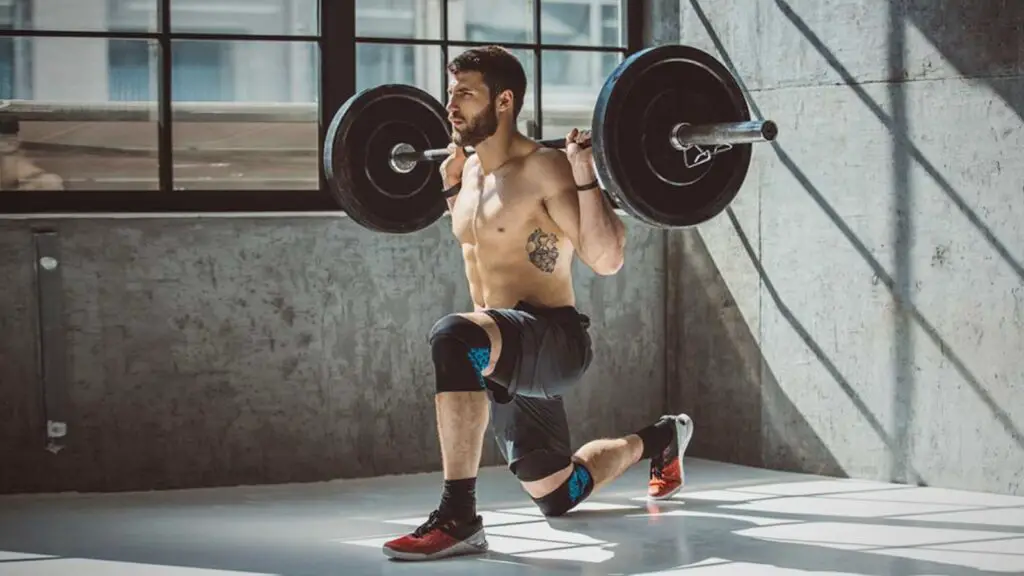
Here are some of the key benefits of incorporating lunges into your workout routine:
- Leg Strength: Lunges target the quadriceps, hamstrings, and glutes, making them an effective exercise for building strength in the lower body.
- Muscle Development: Lunges help increase muscle size and definition in the quadriceps, hamstrings, and glutes, contributing to a toned and sculpted lower body.
- Balance and Stability: Lunges are unilateral (one-leg) exercises, which require balance and stability. Regular practice can improve your balance and coordination.
- Functional Movement: Lunges mimic common movements such as walking and climbing stairs, making them relevant for everyday activities and improving functional fitness.
- Core Engagement: To maintain balance during lunges, your core muscles are actively engaged, which can contribute to improved core strength.
- Flexibility: Lunges involve a dynamic stretch in the hip flexors, which can help improve hip flexibility and reduce the risk of tight hip muscles.
- Variety: There are various lunge variations, including walking lunges, reverse lunges, lateral lunges, and curtsy lunges, which allow you to target different leg muscles and add variety to your workouts.
- Cardiovascular Benefits: When performed with intensity, lunges can increase your heart rate and provide a cardiovascular workout in addition to their strength and muscle-building benefits.
- Injury Prevention: By strengthening the muscles around the knee and hip joints, lunges can contribute to injury prevention, especially in the context of sports and other physical activities.
- Posture Improvement: Lunges can help strengthen the muscles that support good posture, reducing the risk of slouching and poor alignment.
- Minimal Equipment: Lunges can be done with little to no equipment, making them accessible for most people and suitable for home workouts.
To maximize the benefits of lunges, ensure you perform lunges with proper form and gradually increase the difficulty or resistance to challenge your muscles and promote progress.
Cons of Lunges
While lunges offer numerous benefits, there are some potential drawbacks and limitations to consider.
It’s essential to be aware of these cons and take appropriate precautions when incorporating lunges into your fitness routine:
- Knee Strain: Lunges can place stress on the knees, particularly if performed with poor form or excessively deep range of motion. Individuals with preexisting knee issues or injuries should approach lunges with caution.
- Balance and Stability Challenges: Lunges require balance and stability, which can be challenging for beginners or individuals with balance issues. Falling or losing balance during a lunge can result in injuries.
- Hip Flexor Strain: The hip flexors can become tight or strained when performing lunges, especially if the quadriceps are significantly stronger than the hip flexors. This can lead to muscle imbalances and discomfort.
- Overuse Injuries: Excessive repetition of lunges without adequate variation or rest can lead to overuse injuries in the quadriceps or hamstrings.
- Reduced Range of Motion: Some individuals may find it difficult to achieve a deep range of motion in lunges due to flexibility limitations or joint issues, which can limit the effectiveness of the exercise.
- Lower Back Stress: Lunges can place stress on the lower back if performed with improper form. Maintaining a neutral spine and avoiding excessive forward leaning is crucial for lower back safety.
- Impact on Ankles: Lunges can place strain on the ankle joints, especially when the front knee extends beyond the toes. Individuals with ankle issues should be cautious.
- Equipment Dependency: Although lunges can be done without equipment, adding resistance (e.g., dumbbells or a barbell) may require access to additional gear, which might not be readily available in all workout environments.
- Specificity: Lunges primarily target the quadriceps, hamstrings, and glutes. While they offer significant benefits for these muscle groups, they may not fully engage other leg muscles.
To mitigate the cons of lunges and maximize their benefits, it’s important to prioritize safety and proper technique. Here are some tips:
- Start with bodyweight lunges and gradually add resistance as your strength improves.
- Focus on maintaining a neutral spine and proper knee alignment during the exercise.
- Incorporate a variety of lunge variations into your routine to target different leg muscles.
- If you have existing injuries or physical limitations, consult with a healthcare professional or physical therapist to determine if lunges are suitable for your condition.
Like any exercise, lunges should be performed with mindfulness and consideration of individual fitness levels and limitations.
FAQs
Can you do squats and lunges with weights?
Yes, you can add weights to both squats and lunges to increase the intensity and build more strength.
Using perfect form to perform each exercise is the most important thing, before opting for dumbbells and barbells. As a beginner it might be a good idea to use resistance bands, if you want to increase the difficulty.
Which exercise is better for building leg strength?
Both squats and lunges are effective for building leg strength.
Squats are probably the better exercise for building strength, allowing you to use heavier weight while engaging the leg muscles more evenly, compared to lunges that target specific leg muscles.
Are lunges better for flexibility and mobility?
Lunges can be better for flexibility and mobility as they require a greater range of motion, helping to improve hip and lower body flexibility.
Squats are also good, especially when done using single leg. You can check out our article on Lunges vs Bulgarian Squats to see an example of a squat variation that can be used to improve flexibility.
How many reps and sets should I do?
The number of reps and sets depends on your fitness goals.
For endurance, you can do 2-4 sets of 12-15 reps with lighter weights.
For strength, aim for 3-5 sets of 5-8 reps with heavier weights.

